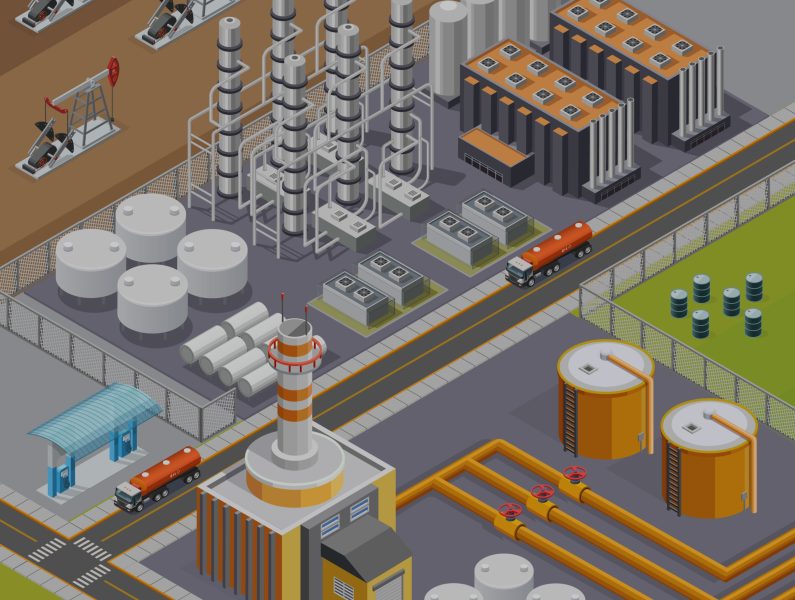Oil & Gas
How the Oil and Gas Industry Works
With an anticipated $5 trillion in worldwide revenue as of 2022, the oil and gas business is one of the largest in terms of dollar value in the globe.
Oil has a significant impact on all aspects of the global economic system, including transportation, heating, energy, industrial output, and manufacturing.
The complicated terminology and distinctive indicators employed throughout the oil and gas business can rapidly overwhelm investors wanting to enter the market. This introduction explains basic ideas and measurement standards in order to assist anyone grasp the fundamentals of businesses working in the oil and gas sector.
The oil and gas industry, which is regarded as the largest industry in the world by dollar value, employs hundreds of thousands of people across the globe and generates hundreds of billions of dollars in revenue annually. These oil and gas firms are so important in the areas where the major NOCs are located that they frequently make a sizeable contribution to the GDP of the country.
What are the different oil and gas sectors?
Three important areas make up the energy sector: upstream, midstream, and downstream.
1) Describe upstream: E&P (exploration and exploitation) is upstream. This include looking for natural gas or crude oil reserves that are underground or under water, drilling exploration wells, and drilling into existing wells to retrieve oil and gas.Since it takes time to find and drill for oil, the upstream sector is characterised by high risks, high investment capital requirements, extended duration, and high technological intensity. Almost every line item on an E&P company’s cash flow and income statement is directly tied to the extraction of oil and gas.
2) Describe Midstream: Is the term used to describe the movement, storage, and processing of oil and gas. When resources are extracted, they must be transported to a refinery, which is frequently located in a separate area than the oil and gas deposits. Tanker tankers, pipelines, and trucking fleets are all examples of transportation.High regulation, particularly regarding pipeline transmission, and low capital risk are further characteristics of the midstream sector. Naturally, the segment is also reliant on the performance of upstream businesses.
3) Describe downstream: The filtering of the raw materials obtained during the upstream phase is referred to as “downstream.” This entails cleaning up natural gas and refining crude oil. Marketing and commercial distribution of these goods to customers and end users in a variety of forms, such as natural gas, diesel, petrol, lubricants, kerosene, jet fuel, asphalt, heating oil, LPG (liquefied petroleum gas), and several other petrochemicals.The refineries and petrol stations are downstream companies. Refineries are the businesses in charge of cleaning up oil and gas before turning it into goods for the general public like petrol, jet fuel, heating oil and asphalt. Where consumers fill up at the pump is the petrol station
Understanding Oil Production Numbers
E&P firms use barrels to gauge oil production. The standard abbreviation for a barrel is bbl, which stands for 42 US gallons. Bbl per day or bbl per quarter are common units used by businesses to describe production.
Using a prefix of “M” to denote 1,000 and a prefix of “MM” to denote 1 million is a standard practise in the oil field. As a result, 1,000 barrels are frequently represented as Mbbl and a million as MMbbl. For instance, seven Mbbl per day, or 7,000 barrels of oil per day, is what an E&P business reports as production.
Understanding Gas Production Numbers
Production of natural gas is measured in cubic feet. Similar to how we refer to oil, Mmcf stands for one million cubic feet of gas. Tcf stands for one trillion cubic feet, while Bcf stands for one billion cubic feet.
Although they are not sized in cubic feet, natural gas futures are traded on the CME Group futures exchange. Rather, the basis for the futures contract is 1 million British thermal units, or MMBtu, which is roughly comparable to 970 cubic feet of gas.
E&P businesses frequently use barrels of oil equivalent (BOE) to measure their production. Companies typically translate gas production into oil equivalent production to compute BOE.
Fuel oil and petrol (petrol) make up the majority of the oil and gas sector’s output. Pharmaceuticals, fertilisers, solvents, and plastics are just a few of the many chemical products that use petroleum as their principal raw material. As the backbone of many nations’ economies, petroleum is crucial to many businesses and is consequently essential to numerous industries.
Oil and gas industry outlook
The oil and gas industry has finally recovered in light of recent low points, including the price collapse in 2013 and significant environmental catastrophes, such the Deepwater Horizon Gulf of Mexico Oil Spill in 2014.
As the world’s industries and infrastructure continue to rely significantly on petroleum-based products, the world’s dependence on oil and gas is growing. Even with a weakening global economy and dwindling oil supplies, discussions about when global oil and gas production would peak seem to be on the fringe. With the U.S. oil and gas industry sustaining at least 10 million jobs, the sector continues to exert enormous impact on global economics and politics, especially when taking employment levels into account.
Applications
Urban Energy
MAN Energy Solutions is the top supplier of integrated power systems in the world. With tailored, flexible, one-source solutions from our wide range of offerings, you may optimise your grid in a variety of ways. The adjustments made to the energy market also have an impact on urban surroundings. We are prepared to create creative energy solutions with you, our customers, based on our extensive expertise.
Our expertise in the field
Our hybrid power solutions provide a solution for integrating renewable energy sources and varying power demands. Our battery energy storage systems (BESS) are used to store excess energy. Engine and turbine gensets fueled by petrol, biofuels or even synthetic fuels can provide instant power top-ups. Our dynamic and extremely efficient power generators emit the least amount of CO2 possible.

Utility energy
MAN Energy Solutions is the top supplier of integrated power systems in the world. Millions of people’s quality of life, business growth, and public infrastructure projects all rely on the energy that utility companies provide. Our goal is to support you in improving your profitability and competitive position. By implementing flexible technology solutions, incorporating renewables, cutting the cost of energy, and reducing emissions, we make sure you can look ahead with assurance.
Our expertise in the field
Providing dependable power to your consumers can be a difficult business. One plant can be all you have to work with. Your grid could perhaps be unstable. Things can get challenging due to outside influences. Your system must respond promptly to load demands and provide economical energy. You must be able to expand your facility if demand increases in the future because you depend on fuel flexibility. Your main source of income is the sale of electricity. You may occasionally operate in difficult or distant terrain.

Industrial energy
MAN Energy Solutions is the top supplier of integrated power systems in the world. There are numerous options to set up independent grids in our wide offering. As a trusted partner to many industrial clients, we are aware of the critical role that an effective and affordable supply of electricity, heat, and cold plays in maintaining competitiveness. MAN will provide your company with long-term energy supply solutions that allow you the adaptability you need to deal with shifting conditions.
Our expertise in the field
We have the ideal options for your company, whether you intend to manage your own electricity supply or require a backup to assist out when your local provider doesn’t provide. Industries often have very variable and high energy consumption. There are many benefits to becoming independent of your local utility. Our hybrid power plants enable improved dependability and cost management. A microgrid that combines thermal power generation, energy storage, and renewable energy sources is not only effective but also actively contributes to decarbonization.


Temperature and level measurement in gas and oil tanks
The liquefaction of the fuel can be carried out underneath a stress of about 10bar whilst cooling the medium at the identical time. Due to the stress and temperature stress on the fabric the tanks are made of exceptional stainless metal and insulated from the hull. Usually spherical tanks that upward jab half-way out of the ship’s deck line are used to transport oil or liquid gas.
LNG strain size at low temperatures
The strain inner the vessel need to be continually monitored due to the fact the liquefaction procedure strongly relies upon on it. To screen the stress inner the vessel at these extraordinarily low temperatures, the medium have to be heated to the stress transducer through evaporation strains at -40°C. The JUMO dTRANS p20 DELTA masters this measuring task.
Need a Consultation? Contact Us 24/7
Innovative Test & Measurement Solutions for Market Leadership














